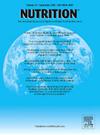拉丁美洲肠外和肠内营养疗法研究--ELANPE 研究 ELANPE 小组
IF 3.2
3区 医学
Q2 NUTRITION & DIETETICS
引用次数: 0
摘要
目的我们描述了 2023 年拉丁美洲几家医院对成年患者进行医学营养治疗的情况,旨在加深对其实施情况的了解,进而促进未来指南的制定。研究采用了一份电子问卷,其中包含筛查、营养治疗、多学科营养支持和监测指标。结果 共有来自 14 个拉美国家的 132 家医院参与了研究,其中 68.2% 为国有医院,中位数为 23 804 名患者。66%的医院(n = 87)系统地实施了营养筛查;NRS-2002(n = 66;75.9%)主要由营养师实施。入院时营养不良的中位数为 33%(IQR = 30.8)。饮食治疗的适应症中位数为 54.4%(IQR = 44.3);口服补充剂为 13.6%(IQR = 18),肠内和肠外营养支持为 14.6%(IQR = 10.2)。大多由营养师(样本数 = 78;59.1%)进行指导。29.5%的医院(n = 39)依靠多学科营养支持。75%(n=99)的医院使用工业化配方,主要是封闭系统(n=53;40.2%)。至于肠外营养,则使用单独配制和预制的溶液(n = 71;53.8%),一般通过中心导管给药。最常引用的监测指标是血液动力学不稳定、代谢并发症、腹胀和胃残留物。入院时的营养不良情况在预期范围内。本文章由计算机程序翻译,如有差异,请以英文原文为准。
Latin American Study on parenteral and enteral nutritional therapy—ELANPE Study ELANPE Group
Objective
We describe the status of medical nutrition therapy in adult patients in several hospitals in Latin America in 2023. with the aim of deepening understanding of its implementation and thus, in turn, contributing to the advancement of future guidelines.
Materials and methods
This is a descriptive, multicenter, cross-sectional study. An electronic questionnaire was applied, containing screening, nutritional therapy, multidisciplinary nutritional support, and monitoring indicators. Descriptive statistics were used in data processing.
Results
A total of 132 hospitals from 14 Latin American countries participated; 68.2% were state-owned with a median of 23,804 patients. In 66% of hospitals (n = 87) nutritional screening is systematically implemented; NRS-2002 (n = 66; 75.9%) applied mostly by dietitians. Median malnutrition at admission was 33% (IQR = 30.8). Median indication for diet therapy was 54.4% (IQR = 44.3); oral supplementation 13.6% (IQR = 18), and enteral and parenteral nutritional support 14.6% (IQR = 10.2). Indication is carried out mostly by dietitians (n = 78; 59.1%). 29.5% (n = 39) of hospitals count on multidisciplinary nutritional support. 75% (n = 99) use industrialized formulas, mostly in closed systems (n = 53; 40.2%). For parenteral nutrition, individually compounded and preprepared solutions are used (n = 71; 53.8%) generally administered by central catheters. Most frequently cited monitoring indicators were hemodynamic instability, metabolic complications, abdominal distension, and gastric residue.
Conclusion
There are still low implementation percentages of nutritional screening, formation of nutritional therapy teams, and use of oral supplements. Malnutrition upon admission is within the expected range.
求助全文
通过发布文献求助,成功后即可免费获取论文全文。
去求助
来源期刊

Nutrition
医学-营养学
CiteScore
7.80
自引率
2.30%
发文量
300
审稿时长
60 days
期刊介绍:
Nutrition has an open access mirror journal Nutrition: X, sharing the same aims and scope, editorial team, submission system and rigorous peer review.
Founded by Michael M. Meguid in the early 1980''s, Nutrition presents advances in nutrition research and science, informs its readers on new and advancing technologies and data in clinical nutrition practice, encourages the application of outcomes research and meta-analyses to problems in patient-related nutrition; and seeks to help clarify and set the research, policy and practice agenda for nutrition science to enhance human well-being in the years ahead.
 求助内容:
求助内容: 应助结果提醒方式:
应助结果提醒方式:


